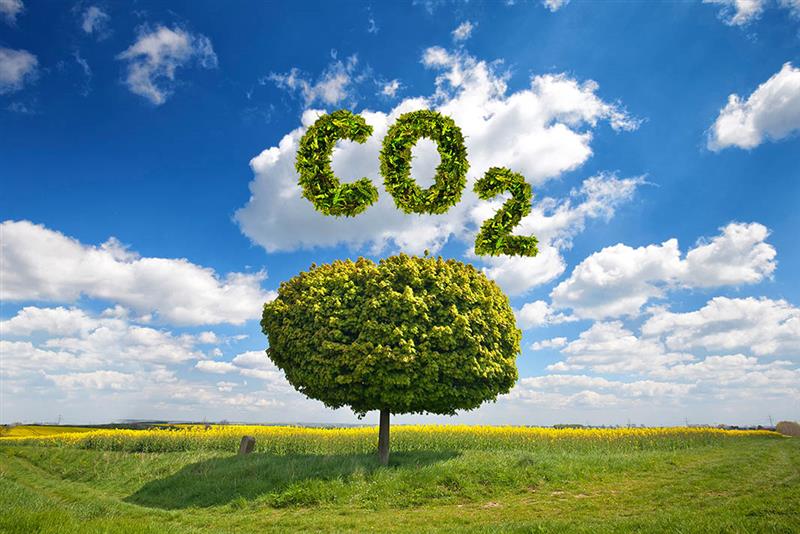Weather
What Are Greenhouse Gases? The Impact Of Greenhouse Gases On Our Planet

What Are Greenhouse Gases – Greenhouse gases have been a topic of much discussion in recent years, as their effects on our planet have become more apparent.
In this article, we will explore greenhouse gases, how they contribute to climate change, and what we can do to reduce our emissions.
What Are Greenhouse Gases?

Greenhouse gases are gases in the Earth’s atmosphere that trap heat, which causes the planet’s temperature to rise. Carbon dioxide, methane, and nitrous oxide are the most common greenhouse gases.
These gases occur naturally, but human activity has significantly increased their levels in the atmosphere.
Carbon Dioxide
Carbon dioxide is the most common greenhouse gas and is primarily released through burning fossil fuels. This gas is also produced naturally through respiration and volcanic activity.
Methane
Methane is another greenhouse gas released through human activities such as agriculture, livestock farming, and landfills. Methane is also produced naturally through wetlands and the digestion of food in animals.
Nitrous Oxide
Nitrous oxide is a less common greenhouse gas but has a greater warming effect than carbon dioxide. It is mainly released through agricultural practices, such as fertilizers and livestock farming.
How Do Greenhouse Gases Contribute to Climate Change?
Greenhouse gases trap heat in the Earth’s atmosphere, which causes the planet’s temperature to rise.
This increase in temperature has a range of effects, including rising sea levels, melting glaciers, and more frequent and severe weather events.
What Can We Do to Reduce Greenhouse Gas Emissions?
Reducing our greenhouse gas emissions is essential to mitigate the effects of climate change. Some ways we can reduce our emissions include:
Using Renewable Energy
Using renewable energy sources such as wind, solar, and hydropower can significantly reduce our reliance on fossil fuels.
Improving Energy Efficiency
Improving energy efficiency in our homes, businesses, and transportation can also reduce greenhouse gas emissions.
Planting Trees and Preserving Forests
Trees absorb carbon dioxide and can help offset greenhouse gas emissions. Preserving forests also helps to reduce emissions by preventing deforestation.
Reducing Waste
Reducing waste and recycling materials can also reduce greenhouse gas emissions by reducing the amount of waste sent to landfills.
Conclusion

Greenhouse gases significantly contribute to climate change, and reducing our emissions is essential to protect our planet’s future.
By using renewable energy sources, improving energy efficiency, planting trees and preserving forests, and reducing waste, we can all play a part in reducing our greenhouse gas emissions.
FAQs
- What are the primary greenhouse gases? The primary greenhouse gases include carbon dioxide, methane, and nitrous oxide.
- How do greenhouse gases contribute to climate change? Greenhouse gases trap heat in the Earth’s atmosphere, which causes the planet’s temperature to rise, leading to rising sea levels, melting glaciers, and more frequent and severe weather events.
- What can we do to reduce greenhouse gas emissions? We can reduce our greenhouse gas emissions by using renewable energy, improving energy efficiency, planting trees and preserving forests, and reducing waste.
- Why is it important to reduce greenhouse gas emissions? Reducing greenhouse gas emissions is essential to mitigate the effects of climate change and protect our planet’s future.
- What role can individuals play in reducing greenhouse gas emissions? Individuals can reduce their greenhouse gas emissions by making changes to their energy use, waste reduction, and transportation habits.
RELATED CTN NEWS:

Weather
Hurricane Beryl Rapidly Intensifies, Becoming First Major Hurricane of 2024 Atlantic Season

(CTN News) – Hurricane Beryl is rapidly intensifying in the Atlantic Ocean, becoming the first named hurricane of the 2024 season.
Beryl is currently a Category 1 hurricane with maximum sustained winds of 75 mph, but forecasters warn it could strengthen into a dangerous major hurricane (Category 3 or higher with winds over 111 mph) before reaching the southeastern Caribbean by late Sunday or early Monday.
A hurricane warning has been issued for Barbados, while hurricane watches are in effect for St. Lucia, Grenada, and St. Vincent and the Grenadines. Tropical storm watches have been posted for Martinique, Dominica, and Tobago.
Meteorologists are stunned by Beryl’s rapid organization and intensification this early in the hurricane season, noting that the storm is developing over exceptionally warm late June waters in the deep tropics.
This is highly unusual, as only 5 major hurricanes have formed in the Atlantic before the first week of July historically.
Impacts and Preparations as Hurricane Beryl Approaches the Caribbean
Beryl is expected to bring heavy rainfall, dangerous storm surge, and hurricane-force winds to the affected islands. Barbados could see up to 6 inches of rain, while a storm surge of up to 7 feet is forecast.
Preparations are underway, with shelters opening and essential services being readied.
The 2024 Atlantic hurricane season is predicted to be extremely active, with forecasts of 17-25 named storms, 8-13 hurricanes, and 4-7 major hurricanes. Beryl’s early development is an ominous sign of what may be to come in the months ahead.
Weather
Punjab, Pakistan Expected to Experience Heatwave with Temperatures Up to 50°C Until Monday

(CTN News) – According to the Punjab Disaster Management Authority, there will be a heatwave in Punjab until Monday, when temperatures may rise as high as 45 to 48 degrees Celsius during the day.
According to the PDMA spokesman, severe heatwave conditions are possible in the Bahawalpur, Rahim Yar Khan, DG Khan and Multan districts of Southern Punjab.
Record High Temperatures in Sindh Amid Heatwave
All concerned departments have been instructed to remain alert to any untoward situation. According to the spokesman, citizens are being made aware of the dangers of the heatwave through the media.

A heatwave that has been affecting major cities throughout Sindh has continued. On Friday, the maximum temperature soared to a record 51 degrees Celsius.
According to the Met Office, Mohenjo Daro was the hottest place in the country last week, with a maximum temperature of 51°C, followed by Jacobabad and Khairpur (both 50°C).
In Larkana and Dadu, the maximum temperature reached 49°C, while in Rohri and Sukkur, it reached 48.5°C, while in Padidan, it reached 48°C, in Shaheed Benazirabad, it reached 46.5°C, in Mithi, it reached 46.5°C, in Sakrand, it reached 46°C, while it reached 44.5°C in Tando Jam and Hyderabad, it reached 44.5°C.
Karachi’s weather was hot, too. The maximum temperature reached 36.7°C, and the humidity count was 55 percent, indicating a lot of moisture in the air.

According to the Met Department’s daily advisory, “very hot” weather is expected to be experienced in most parts of Sindh, including Karachi, during the next 24 hours.
A similar warning was issued for the province’s coastal areas, stating that “humid conditions” would also prevail there.
As a result, the daytime temperatures in upper districts of Sindh are expected to remain six to eight degrees centigrade above average during this period, according to the report.
If people need assistance in an emergency, they can contact the PDMA’s Helpline number 1129 or Rescue number 1122.
Weather
Meteorological Warns of Summer Storms as Heatwave Continues

Thailand’s Meteorological Department Summer has reported that storms are forecast to provide relief from weeks of scorching heat from Friday to Tuesday, but residents should be prepared for high winds and hail.
Winds from the West, Southeast, and South are forecast to reach exceptionally hot regions in the Central Plains, as well as the country’s northern and northeastern regions, according to the report released Thursday.
From Friday to Sunday, upper portions of the North and Northeast should expect a boost in westerly winds. Then, on Monday and Tuesday, winds from the south and southeast will hit the northeast, east, central plains, and lower north.
As a result, residents can expect summer storms, including hailstorms, in the North, Northeast, and Central Plains on Friday and Saturday, as well as in the North, Northeast, Central Plains, and East from Sunday to Tuesday.
The Meteorological Department predicted that the wet season will begin in earnest around the fourth week of this month.

Nationwide Heatwave
Thailand is experiencing an extreme heatwave. The Southeast Asian country is experiencing record-breaking heat, with temperatures rising beyond 40°C (104°F) in numerous areas. Authorities have issued health warnings, advising residents and tourists to stay hydrated and avoid excessive sun exposure.
The searing heat has taxed electrical infrastructure, resulting in intermittent blackouts as air conditioners operate at full capacity. Schools have modified their schedules or closed temporarily, while outside workers struggle to cope with the relentless light. Hospitals have reported an increase in heat-related ailments, notably among the elderly and young children.
Agricultural sectors are not immune either. Thailand’s important rice and fruit exports could suffer losses owing to crop damage and reduced yields. Farmers are looking for solutions to protect their crops, including shade nets and greater irrigation. If the heatwave continues, it might have a severe economic impact.
While heatwaves are not uncommon in Thailand’s tropical environment, experts attribute this year’s severity to climate change. They warn that extreme weather events will become more common and severe, creating significant challenges to the country’s infrastructure, public health, and critical sectors.
-

 News4 years ago
News4 years agoLet’s Know About Ultra High Net Worth Individual
-
Entertainment2 years ago
Mabelle Prior: The Voice of Hope, Resilience, and Diversity Inspiring Generations
-

 Health4 years ago
Health4 years agoHow Much Ivermectin Should You Take?
-

 Tech2 years ago
Tech2 years agoTop Forex Brokers of 2023: Reviews and Analysis for Successful Trading
-

 Lifestyles3 years ago
Lifestyles3 years agoAries Soulmate Signs
-

 Movies3 years ago
Movies3 years agoWhat Should I Do If Disney Plus Keeps Logging Me Out of TV?
-

 Health3 years ago
Health3 years agoCan I Buy Ivermectin Without A Prescription in the USA?
-

 Learning3 years ago
Learning3 years agoVirtual Numbers: What Are They For?